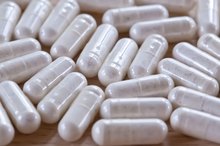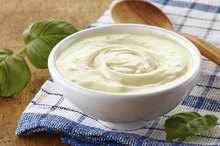What does fact checked mean?
At Healthfully, we strive to deliver objective content that is accurate and up-to-date. Our team periodically reviews articles in order to ensure content quality. The sources cited below consist of evidence from peer-reviewed journals, prominent medical organizations, academic associations, and government data.
- NIH Medline Plus for more abour Lactobacillus cidophilus
- Indian Journal of Medicine
- Indian Journal of Medicine
- National Institutes of Health
- National Institutes of Health
The information contained on this site is for informational purposes only, and should not be used as a substitute for the advice of a professional health care provider. Please check with the appropriate physician regarding health questions and concerns. Although we strive to deliver accurate and up-to-date information, no guarantee to that effect is made.
Probiotics-- often called "friendly" or "good" bacteria-- are live, lactic-acid producing microorganisms that are similar to those found in the human digestive tract. These beneficial bacteria are associated with numerous health benefits. They are also widely used in clinical nutrition and complementary alternative medicine. Experts at the National Institutes of Health note that probiotics show some promise in the treatment of diarrhea, irritable bowel syndrome, vaginal infections, tooth decay and skin disease 3.
If you are experiencing serious medical symptoms, seek emergency treatment immediately.
Probiotics are found in commercial supplements, as well as fermented foods like tempeh, miso and yogurt. The majority of probiotic microbes are members of the Lactobacillus or Bifidobacterium genera, and many species, sub-species and strains exist within these two categories. Additionally, some food manufacturers use patented or proprietary strains that are unavailable through other sources.
Lactobaccilus Acidophilus
L. acidophilus is one of the most common and versatile probiotics on the market. It is frequently used in yogurt cultures and hundreds of subspecies and strains have been developed. According to the National Institutes of Health, L. acidophilus' most reliable use is in the treatment of bacterial vaginosis 3.
Lactobacillus Rhamnosus
List of Probiotic Bacteria
Learn More
Lactobacillus rhamnosus shows some medicinal effects similar to its relative, L. acidophilus, but it is more expensive and has not been subjected to the same amount of study. The "Indian Journal of Medical Microbiology" notes that it "has proven beneficial affects on intestinal immunity. 2"
Bacillus Coagulans
Once erroneously classified in the Lactobacillus genus, B. coagulans is relatively rare on the supplement market. Unlike Lactobacillus and Bifidobacterium species, B. coagulans has never been used in commercial foods.
Bifidobacterium Animalis
Probiotics & Stomach Flu
Learn More
B. animalis is famed for its ability to improve digestive regularity. It is frequently used for people with irritable bowel syndrome or chronic constipation. One subspecies of B. animalis is used by the yogurt manufacturer Dannon, which markets strain under the patented name "Bifidus regularis."
Escherichia Coli
While E. coli is rarely considered to be a "good" species of bacteria, some nonpathogenic strains actually hold therapeutic value. One Japanese study, published in 2005 by the journal "Inflammatory Bowel Disease," found that friendly strains of E. coli can actually prevent and treat ulcerative colitis.
Lactococcus Lactis
L. lactis has only limited medicinal value compared to other probiotic species, but it offers extensive commercial and culinary value. Almost all forms of cheese and buttermilk are manufactured using appropriate strains of L. lactis.
Lactobacillus Reuteri
Sometimes called the universal probiotic, L. reuteri is found in the colons of most animals, where it can fight pathogenic bacteria. L. reuteri is found in human breast milk and may be responsible for some of the immunosupportive and anti-gas effects associated with breastfeeding.
Related Articles
References
- NIH Medline Plus for more abour Lactobacillus cidophilus
- Indian Journal of Medicine
- National Institutes of Health
- Allgeyer, L. C., Miller, M. J., & Lee, S. Y. (2010). Sensory and microbiological quality of yogurt drinks with prebiotics and probiotics. Journal of Dairy Science, 93(10), 4471-4479.
- Falagas, M. E., Betsi, G. I., Tokas, T., & Athanasiou, S. (2006). Probiotics for prevention of recurrent urinary tract infections in women. Drugs, 66(9), 1253-1261
- Mortazavian, A. M., Ehsani, M. R., Mousavi, S. M., Rezaei, K., Sohrabvandi, S., & Reinheimer, J. A. (2007). Effect of refrigerated storage temperature on the viability of probiotic microâorganisms in yogurt. International Journal of Dairy Technology, 60(2), 123-127.
Writer Bio
Juniper Russo, an eclectic autodidact, has been writing professionally since 2008. Her work has appeared in several online and print-based publications, including Animal Wellness. Russo regularly publishes health-related content and advocates an evidence-based, naturopathic approach to health care.









